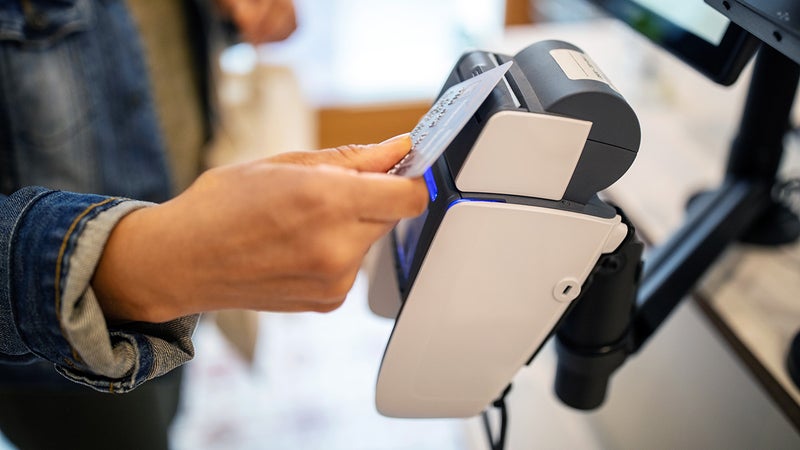How to choose a secured credit card: 7 things to look for

The Bankrate promise
At Bankrate we strive to help you make smarter financial decisions. While we adhere to strict , this post may contain references to products from our partners. Here's an explanation for . The content on this page is accurate as of the posting date; however, some of the offers mentioned may have expired. Terms apply to the offers listed on this page. Any opinions, analyses, reviews or recommendations expressed in this article are those of the author’s alone, and have not been reviewed, approved or otherwise endorsed by any card issuer.
Key takeaways
- Secured credit cards allow you to place a deposit with a credit issuer in order to access a line of credit — typically equivalent to your deposit amount.
- Because of the way secured credit cards work, you’re able to build or rebuild your credit, while issuers gain a degree of certainty that granting you credit won’t result in a financial loss.
- But although most secured credit cards work this way, individual cards have their own requirements, restrictions and rewards.
- Before signing up for a secured card, take the time to review what to look for in a secured card to find the right fit for you.
A secured credit card can provide you with an opportunity to build your credit history from scratch or to rebuild your credit after it’s taken a hit. But with so many secured card options on the market to choose from, it’s easy to get overwhelmed.
One tip: Keep in mind that the primary purpose of a secured credit card is to help improve your credit history to the point where you can qualify for better card options. So you don’t necessarily need to focus on the long-term value you can get from the card.
That said, it’s important to consider each card’s benefits to make sure you get the best experience and that your efforts actually help build your credit history. Here’s how to choose a secured credit card before signing on the dotted line.
1. Credit reporting
In most cases, credit card companies report your account activity, such as your balance and payment history, to the three major credit bureaus: Experian, Equifax and TransUnion. If you get a secured credit card from a major card issuer — the Capital One Platinum Secured Credit Card or the Citi® Secured Mastercard®*, for example — this feature is standard.
However, if you’re getting a secured credit card from a lesser-known card issuer, it’s possible your activity will only be reported to one or two of the credit bureaus. The problem with that is that different issuers can pull data from different credit bureaus when making lending decisions. For example, if you get a secured card with a bank that only reports to Experian, and you apply for a loan with a lender that only checks your Equifax and TransUnion credit reports, it’ll be as if all of your hard work never happened.
2. Costs
It’s easy to find a secured credit card that doesn’t charge an annual fee, especially if you’re going with a major card issuer. But there are secured cards that do charge an annual fee.
In some cases, these cards may make up for it by offering a lower interest rate. For example, the First Progress Platinum Prestige Mastercard® Secured Credit Card charges a $49 annual fee but comes with a lower-than-average APR.
But if you find a card that charges an annual fee and doesn’t give you anything of value in return, it’s probably not worth it.
In an ideal world, you wouldn’t need to worry about a credit card’s interest rate. If you can pay your bill on time and in full every month, you can avoid interest charges entirely. But if your financial situation makes it challenging to do that, try to get as low an APR as possible.
Also, note that while there are some unsecured credit cards out there you can get with bad credit, you’ll want to watch out for exorbitant fees. Some of these cards charge an upfront processing fee just to open the account, as well as monthly fees on top of their annual fees. In some cases, the interest rate can be upwards of 30 percent, which is unheard of among top secured cards. It’s best to avoid these cards.
3. Grace period
A credit card grace period is the span between your statement date and your due date. During this time, you won’t pay any interest as long as you pay your statement balance from the previous month in full.
If a credit card doesn’t offer a grace period — and not all do — your purchases start accruing interest from the date of the transaction. With no grace period, a secured credit card can get expensive fast, so getting a card that has one should be a top priority.
Fortunately, most of the top secured credit cards offer a grace period. But even with one, it’s important to set up automatic payments on your account as soon as it opens so you don’t accidentally miss a payment and get hit with interest and a late payment fee.
4. Security deposit requirements
One of the biggest drawbacks of a secured credit card is the deposit requirement. Most people who are new to credit or have poor credit don’t have lots of excess cash they can lock up with a credit card for several months.
As a result, it’s important to consider each secured credit card based on the affordability of its deposit. In many cases, you can find a card with a minimum deposit of $200 or $300, with your credit limit equal to your deposit amount. The Capital One Platinum Secured Credit Card is an exception, offering an initial $200 limit for a deposit as low as $49, depending on your creditworthiness.
As you compare deposit requirements, it’s important to remember that a lower credit limit typically makes it harder to maintain a good credit utilization ratio (the percentage of your available credit that you’re using at any given time). As you work to build credit, it’s best to keep this rate as low as possible.
5. Upgrade options
Historically, you couldn’t get your deposit back on a secured credit card unless you closed your account. But there are a few card issuers willing to upgrade your account to an unsecured card after a while.
With the Discover it® Secured Credit Card, for instance, you can “graduate” to an unsecured account. Discover begins automatic reviews of your account starting at 7 months to see if they can transition you to an unsecured line of credit and return your deposit. The Capital One Quicksilver Secured Cash Rewards Credit Card is another example, though the card issuer doesn’t disclose when an upgrade is possible.
Having a secured card that can be converted to an unsecured credit card is important because it gives you the ability to keep the account open, even after you’ve outgrown it. Keeping old credit card accounts open can help build your credit by increasing the length of your credit history, especially if you have a track record of on-time payments on the account.
6. Eligibility requirements
On the surface, it might seem like secured credit cards should guarantee approval. After all, you’re typically securing the entire credit line with cash that the card issuer can keep if you default.
But card issuers may still deny your application if your income or credit history doesn’t meet its requirements. For example, Capital One won’t approve your application if you’re past due on another Capital One account.
Also, you generally can’t get any credit card if your credit report reveals a bankruptcy that hasn’t been discharged. Some card issuers may even have a waiting period after the discharge date.
As you compare your options, check to see if each card issuer has a preapproval process that can give you an idea of your approval odds. Also, read the fine print or consider calling the card issuer to learn about potential disqualifiers and whether they apply to you.
If your credit situation is in dire straits, the OpenSky® Secured Visa® Credit Card could be a solid choice because it doesn’t require a credit check to apply.
7. Card benefits
The ultimate goal of a secured credit card is to build or rebuild credit, but it doesn’t hurt if the card you’re using also offers rewards and perks along the way.
For example, the Capital One Quicksilver Secured Cash Rewards Credit Cards offers 1.5 percent cash back on every purchase you make, a rate that rivals some of the best cash back credit cards on the market. What’s more, the card has no annual fee and gives you the chance to get your deposit back without closing the account.
Similarly, the Discover it® Secured Credit Card offers 2 percent cash back on up to $1,000 spent in combined purchases quarterly at gas stations and restaurants, as well as 1 percent back on everything else for no annual fee. Additionally, Discover will automatically match all the cash back you’ve earned at the end of your first year.
The bottom line
If you’re looking for a secured credit card to build or rebuild your credit history, avoid the urge to accept the first offer you see. Instead, take your time to research your options and compare card features to determine the right fit for you.
While you likely won’t use your secured credit card forever, a good one can make your life a little easier and even offer added value while you work to build your credit.
*The information about the Citi® Secured Mastercard® has been collected independently by Bankrate.com. The card details have not been reviewed or approved by the card issuer.




